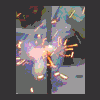Just gauging interest and collecting some thoughts on a project I have been working on for a long time:
I have been developing a modular firing system using an automotive 1 wire comms interface (LIN bus). It supports up to 128 units each with 20 cues, it reads a script file in .csv format (editable in excel) from SD card, and has a minimum cue to cue time of 0.1 seconds. Each unit can be polled for connectivity, and each cue can be continuity tested and reported back to an LCD on the master.
I'm hoping to release the master software as open source for the Arduino platform, possibly sell a shield to make construction simpler, and sell the slave units (these are PIC based and all surface-mount, so would be awkward to build for the non-technical). This way I hope to get around some of the liabilities incurred with selling a complete system, i.e. what happens if someone were to accidentally fire a cue and cause damage or injury.
The slave units are mounted in a waterproof diving box approx 200mm x 120mm, the panel has speaker terminals like the ones pictured, however the PCB will take up the entire box and the edges will be silicone sealed (current prototype is MDF to save PCB costs during development).
The components will all be located on the bottom side of the panel, and conformal coated to prevent moisture damage if it does somehow get past the silicone. Each unit will have 2 panel mounted 3.5mm headphone-style connectors, which will be plugged with a rubber bung when not used, for ingress protection. The 3.5mm connectors will carry +12V, ground and signal to each unit, and they can be daisy chained. The great thing about these cables is that you can buy them very cheaply (i.e. £2 for 20m from eBay), and each unit has a fairly large capacitor therefore cable resistance does not become a problem on normal firing sites of less than 40 metres, this is the guaranteed working limit of the LIN system anyway. The capacitor charge time over 40 metres of poor quality cable is still less than the 100mS between cues, so if someone had shorted an output connection by mistake and the unit went into reset, it would be 'alive' by the next command and would not miss a firing instruction.
Each unit has to be bought with an address in mind, so for most users 1, 2 and 3 would be appropriate for 3 point firing, though for those that always mirror the left and right sides they may wish to buy 2 of address 1 for the outers, and 1 of address 2. The alternative to this would be that the user buys a PICKIT2 for around £30 and uploads their own code into the slaves via the test points.
The key thing with this has been to keep it within reach of hobbyists, so I am hoping to sell these slave units around the £100 mark, this would include support in getting the master that you'll have built yourself working successfully. I envisage the master shield to cost around £60 including LCD and card reader but have not done cost calculations on bulk purchase yet for this.
I will be placing a sample order for 100 sets of parts in the near future, and would like to see if I have missed any crucial features / obvious improvements I could make at little or no extra cost. I would also like to know if people think that the price is acceptable for the slave units.
Pictures of prototype unit - note that the final build will be all FR4 PCB top panel rather than MDF, so the connectors will be soldered directly in rather than wired. The 3.5mm sockets will also be panel mounted rather than loose on wires.
Sorry for the gigantic post but I would appreciate any questions or comments you may have.
Paul

















